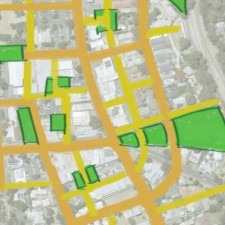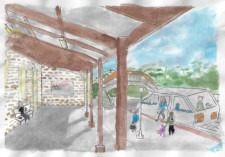Urban form
Blackwood is an amorphous suburban blob, slopping across the hilltop.

It has no real form, no shape, few boundaries or edges to nurture and shelter people. It’s mostly road and carpark, rather than a human habitat.
A strong urban form is a critical first step in creating a new place.
At this scale we are visualising ‘macroforms’ – the shape of Blackwood, in the landscape, as a composition of large scale elements.
Fantasy Towns
We promised to start with fantasy so let’s look at some of our favourite towns from fantasy and science fiction. All these fantasies have a strong narrative that allows us to accept their internal logic.
A town, it’s people and happenings are one of the ways a story gains depth and background and becomes real.
These towns resonate because they are based on archetypal forms of human settlement across different geographies and cultures.
These towns have some common characteristics.

Image: Guild of Ambience You Tube
A strong form, derived from local topography such as the hilltop town or the island city, and from concentrating built form within a distinct boundary, usually derived from a defensive perimeter. The walled hilltop town comes up regularly as a favourite.
Towns also have a centre, often taller and more prominent, with important civic or religious functions.
And fantasy towns have lots of people: people living all around, and people working in businesses; the blacksmith, the fishmonger, the markets, the potion shop, the priests and soldiers and Kings and Queens.
An organic macro-form growing out of the landscape is common in fantasy town and cities. Topography blends with walls, natural materials abound, and buildings grow and sprout like branches and leaves.
Examples
Here are some examples from human imagination, based on archetypal urban forms.
Dale
J.R.R. Tolkien's TheHobbit. Image Peter Jackson's Hobbit Trilogy

A beautifully imagined hilltop town, houses rising from the walls, winding streets and lanes, an organic form of tumbling stone buildings rising to the peak of the civic centre.
Unfortunately, the walls did not protect it from Dragons!
Minis Tirith
Minis Tirith rises dramatically from the Pelennor Fields. Split by the great spur of rock and surmounted by the Citadel.
Could Blackwood have a spur looking out over Hawthorndene and North to Mount Lofty? Are its Pelennor Fields the leafy suburban hillsides and valleys below the Hilltop?
Minis Tirith probably has accessibility issues even worse than Blackwood’s!

J.R.R. Tolkien's Lord of the Rings. Image from Peter Jackson’s LOTR Trilogy.

Robert Jordan’s Wheel of Time. Image from Amazon Prime’s Wheel of Time
Tar Valon
"The Wheel of Time turns around Tar Valon, and Tar Valon turns around the Tower."
A secure and walled island city, Tar Valon is bounded by a river with the White Tower rising in the centre. Six bridges and north and south river ports support its role as a trade hub. The central tower reflects its role as the seat of Aes Sedai power.
Theed
Theed is the sprawling capital city of Naboo, but this image of the compact Royal Palace is the classic meme of the hilltop palace/castle, unlikely waterfalls, and fantastic engineering.
Star Wars buildings tend not to have many windows – is this defensive, or because they clutter up the striking and organic forms of the buildings?
I first saw Star Wars in 1977 at the Blackwood Memorial Hall, and it was the fantastic imagery that made it an instant cultural icon. A time and a place, long ago and far away, had never before been so real.

Image Disney Star Wars

J.R.R. Tolkein's Lord of the Rings. Image from Peter Jackson’s LOTR Trilogy.
Edoras
“from the shadow of the vale a green hill rises upon the east. A dike and mighty wall and thorny fence encircle it. Within there rise the roofs of houses; and in the midst, set upon a green terrace, there stands aloft a great hall of Men.” Legolas in LOTR.
A classic walled hilltop town, Edoras can be defended, and is an urban centre for the rangelands of the Rohirrim.
Peter Jackson’s Edoras always seems a bit underpopulated and low density to me, but maybe reflects the horseback nation of Rohan and their vast open spaces. That lack of compression is what makes it so much less defendable than Helm’s Deep, to which Rohan is forced to retreat by Saruman’s Uruk-hai
Gormenghast
Gormenghast is a vast, ancient gothic pile, a castle mutated into a town. Gormenghast is full of rich descriptions of places and spaces, and the complex and pointless rituals that occur within. Not somewhere you might really want to live, but an astonishingly evocative place.
Around the walls are villages clinging to the edges much as suburban Blackwood washes up against the urban centre.

Novel by Mervyn Peake. Artwork by Ian Miller.

George R.R. Martin’s Game of Thrones. Image HBO’s G.O.T.
Winterfell
Winterfell sits astride a ridge with some similar topography to Blackwood, More a fort than a full town, it still has a solid density and definite presence.
Jedha
This Star Wars city was inspired by Middle Eastern holy cities. It’s a vast desert mesa with ancient walls, and a dense, hot climate city behind.
Like Dale its walls proved useless against a fiery aerial attack, in this case the brand new Death Star

Rogue One a Star Wars story. Images from Disney Star Wars

A Dungeons and Dragons adventure artwork published in White Dwarf 42.
Illirian
This has all the romance of an old, fantastic, higgledy piggledy town. Roof tops and lanes, prowling cats, and secret lives. The town and its inhabitants were beautifully described in the adventure.
I bought this, my first White Dwarf Magazine, in a little games shop on a winding, hilly cobblestone lane in Norwich, where my parents and I briefly lived in 1982. This image seemed to be a fantastic version of the real old English town I found myself in.
Takabo
This is an obscure one, but I came across this image and loved its exaggerated, organic form, which nevertheless springs from the walled town archetype. It's also part of a network, with another node visible in the distance.

Disney Star Wars. Image from Wookieepedia.
Conclusion
These are all fantastical images but represent some similar urban forms.
We know Blackwood’s general form is derived from its hilltop location at the junction of two ridge lines: one leading to the coast, one parallel to the line of the Adelaide Hills, with historical and ancient routes down to the plains and out to rangelands.
In another time, place or parallel universe, Blackwood could have grown from a walled hilltop town on this crossroads, an archetypal human settlement form, and would look very different, and have a much stronger sense of place.
Can the hilltop town archetype be useful as a macro-form for our Blackwood, on its own hilltop, in this time and universe?

Feature Image: Detail from the cover of When the Red King Comes by Elfpower




